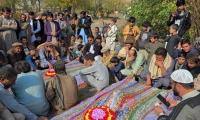The recent motorway gang-rape incident calls for retrospection on the absence of a gendered response to policing. The serving Lahore Capital City Police Officer’s (CCPO) victim-blaming in response to the incident brought disgrace for all ranks of Pakistan’s police service community and shattered the public’s trust.
The CCPO’s apology cannot repair the Pakistani police’s damaged image. The government of Punjab’s claims related to reaching the culprits within 72 hours could also be perceived as a self-serving tactic to shift public perception and rebuild the lost credibility of the police force. Both the police and the provincial government simply cannot restore the public’s confidence or win accolades for claimed efforts.
The incident occurred near the provincial capital of Punjab, enraged Pakistani citizens, and became a media spectacle, thus inviting the government and police force’s immediate investigative attention. If the rape had occurred in a rural backwater’s village targeting a marginalized female villager, as has been common in Pakistan, it would have been more complex and possibly never reported – just dismissed or inaccurately recorded. A previous study in a 2012 report by the Asia Society’s Independent Commission on Pakistan Police Reform indicated that a woman’s class and residence (rural/urban) are the primary factors of a police official’s response to their complaint.
While notions of masculinity and patriarchy are obvious in the police’s rhetoric which stressed that this incident occurred due to the female victim’s fault of her own, it automatically gave protection to the male perpetrator and normalized rape as a consequence of women’s actions. It is also interesting to observe the senior police leadership’s self-confidence, carelessness, and callousness in releasing the manipulative statement. This confidence is intrinsic as well as systematic – it reflects the wider unequal power relations between men and women which contribute to women’s subordination in society and stifle their voices. It stems from a deep-rooted patriarchal mindset, which discourages women from seeking justice, creates distrust, and significantly lowers reporting of sexual violence cases and conviction in Pakistan. The police are an absolute last resort in most cases.
Pakistan police’s inability to swiftly tackle sexual violence and abuse cases involving women is evident. In this case, the survivor’s chosen actions and behavior became the center of national discourse to disguise the poor quality of investigation and accountability as well as failure to swiftly respond to the women’s call for help. Gender discrimination and cultural bias pervade police investigation and lower neutrality. The prevailing narrative supported by law-enforcement agencies allowed space, freedom, and justification to the perpetrators for their heinous crimes.
There has also been an ownership problem given the occurrence of blame-shifting between police departments as efforts were made to steer clear of responsibility and jurisdiction and dismiss exposed inadequacies and mis-coordination.
The high-level verdicts that followed the incident were shocking too. Prime Minister Imran Khan launched an impractical wish list and desire for public hanging of the criminal, whereas he could have advocated for police forces to improve oversight, adopt tech for criminal investigation, and enhance gender sensitive policing to address the security needs of women and children. He also blamed “Bollywood” for Delhi becoming the rape capital of the world. Why did the premier not say that rape happens simply because of the rapist?
This kind of public discourse on rape led by the political leadership only serves to give more confidence to perpetrators. Quality essential justice services must protect and support Pakistan’s GBV victims. Police officers are responsible for dealing with victims with high levels of dignity and respect since this does impact the investigative decision-making. Empathetic policing in investigating rape and assault cases is critical for first responders and senior police personnel. The police’s radical portrayal of the incident was flawed and did not account for the victim’s trauma. It also reflected indifference, compassion fatigue, and burnout.
Reporting sexual assault and domestic violence is severely insignificant in Pakistan because of several factors – including the expectation that police involvement will further aggravate the problem. Female survivors/victims of abuse are hesitant because the process of lodging the First Information Report (FIR) itself is complicated and grueling. Women face several constraints including mobility restrictions in reaching local police stations. The very moment a Pakistani woman decides to step up for herself lodge a complaint, and enter a police station, she is bombarded with societal judgement, scepticism, privacy invasion, and antagonizing attitudes of police officers. She does not see any women police officers who could potentially relate to her predicament.
This is why Pakistan stands at a low three percent conviction rate in rape and sexual assault, according to news reports.
The police force is dominated by men as gender stereotypes still pervade law-enforcement institutions and male power continues to be reinforced. It is not surprising that female representation is shockingly low in provincial police departments. At present, 6899 female police officers are working throughout Pakistan against the 465,035 sanctioned strength of police, according to statistics from the National Bureau of Police.
Women’s recruitment in decision-making authoritative roles in the police force is far and few in between. There is global evidence that women as leaders and decision-makers in policing can be role models for the community and respond effectively to women complainants. However, attracting more women to policing careers is impossible unless there is widespread gender sensitization and a revamped public image of the police which is genuine and not a mere stage performance.
The government’s ongoing efforts to effectively cater to complaints of women, transgender persons, and other vulnerable members of society, such as the establishment of a women’s helpline or a women’s safety mobile application, will not have adequate results unless there is supporting mass public awareness, gender sensitization, and community-level dialogue.
Outreach and publicity should not only be donor-driven and limited to savvy reports, high-level press statements, websites, and campaigns executed in silos. There is urgent need for more than just conversation on mainstreaming gender in policing. Women must be at the epicenter of institutional level police reforms to drive a gender-balanced perspective on policing. The reforms must account for perspectives of female victims who have experienced police hostility.
There should be intense focus on sensitized approaches towards policing practices and specialized training which give officers insights into dealing with GBV survivors and humanizing the investigative process. A conducive environment should be created in police departments where women can perform, and their posting should be linked with performance and not their gender. Women-only desks should be established in all police stations to cater to the increasing GBV crimes in Pakistan. Further concrete action beyond stakeholder dialogue and hotel roundtable conferences needs to be taken so that policing can cater to women and not just men in Pakistan.
The writer is a communications and government affairs expert and Chevening scholar who studied at the LSE, London.
MPAs ask for their salaries and benefits to be at par with high court judges and exempt from tax
This system fosters and places premium on VIPs, facilitating VIP culture, which is alive and kicking
Imagine this waste covering over 15,500 cricket stadiums, piled three meters deep every year
If there is one thing that can be gleaned from politics today, it is that we no longer speak same language
Postman argues that “typographic mind” was yielding to “televisual mind”
Pakistan is well poised to meet opportunities that Artificial Intelligence will offer for developments in industries







